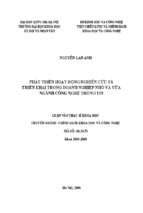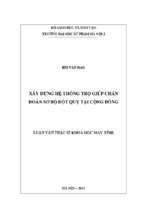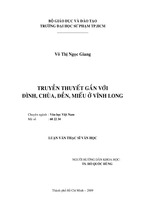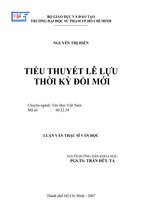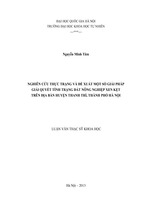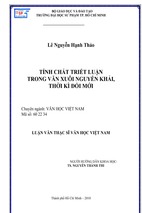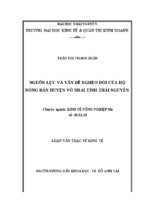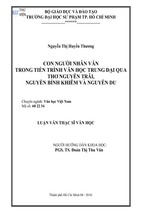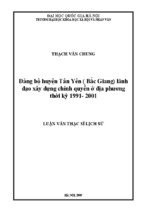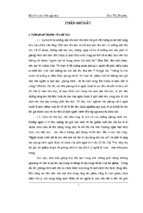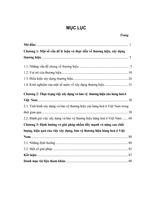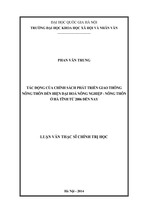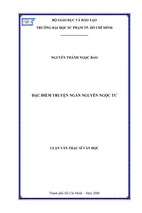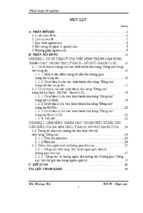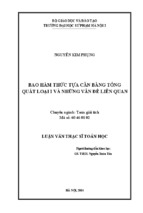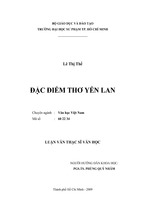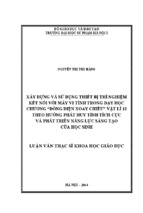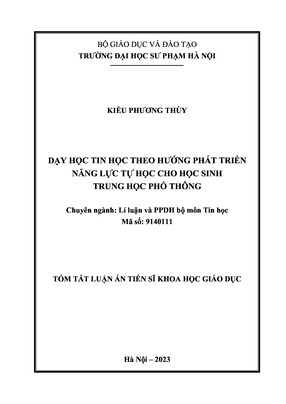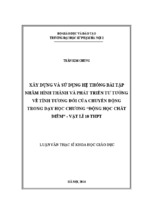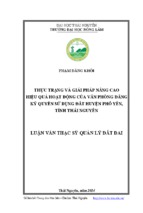TABLE OF CONTENTS
TABLE OF CONTENTS ............................................................................ i
LIST OF TABLES ..................................................................................... iv
ABBREVIATIONS .................................................................................... vi
ABSTRACT ...............................................................................................vii
CHAPTER I. INTRODUCTION .............................................................. 1
1. Research Motivation ....................................................................................... 1
2. Research Question .......................................................................................... 2
3. Research Purpose ............................................................................................ 2
CHAPTER II. LITERATURE REVIEW ................................................. 3
1. Ba Be National Park ....................................................................................... 3
2. Personal Benefit from Tourism Development ................................................ 8
3. Community Attachment ................................................................................. 9
4. Tourism Impacts ........................................................................................... 10
���5HVLGHQWV¶�$WWLWXGH�WRZDUG�7RXULVP�'HYHORSPHQW ...................................... 13
1) Social Exchange Theory ...................................................................................... 13
���5HVLGHQWV¶�$WWLWXGH�WRZDUG�7RXULVP�'HYHORSPHQW� .............................................. 15
6. Participation in Tourism ............................................................................... 18
7. Stakeholders .................................................................................................. 19
CHAPTER III. METHODOLOGY ........................................................ 22
1. Measurement Variables ................................................................................ 22
2. Research Model ............................................................................................ 25
3. Research Hypotheses .................................................................................... 28
1) Relationship between Personal Benefit and Perception of Tourism Impacts ...... 28
i
2) Relationship between Community Attachment and Perception of Tourism
Impacts ..................................................................................................................... 28
3) Relationship between Perception of Tourism Impacts and Support for Additional
Tourism Development .............................................................................................. 29
4) Relationship between Perception of Tourism Impacts and Participation in
Tourism .................................................................................................................... 30
5) Relationship between Support for Additional Tourism Development and
Participation in Tourism ........................................................................................... 30
6) Differences among Variable Groups of Tourism Experience and Tourism Related
Job Status .................................................................................................................. 31
4. Site Selection ................................................................................................ 32
5. Sampling and Data Collection ...................................................................... 32
6. Methods of Analysis ..................................................................................... 33
CHAPTER IV. RESULTS ....................................................................... 34
1. Descriptive Analysis about Local Residents ................................................ 34
2. Factor Analysis ............................................................................................. 44
3. Correlation Analysis ..................................................................................... 55
4. Regression Analysis ..................................................................................... 57
1) Regression Analysis of Tourism Impacts Perception .......................................... 57
2) Regression Analysis for Support and Participation in Tourism Development ....... 58
5. Independent Samples T-test .......................................................................... 60
6. Results of analysis ........................................................................................ 63
CHAPTER V. DISCUSSIONS AND CONCLUSIONS ........................ 68
1. Discussions ................................................................................................... 68
2. Implications .................................................................................................. 73
1) Theoretical Implications ...................................................................................... 73
2) Managerial Implications ...................................................................................... 74
3. Limitations and Future Research .................................................................. 75
ii
REFERENCES .......................................................................................... 77
APPENDIX 1 ............................................................................................. 85
APPENDIX 2 ............................................................................................. 86
APPENDIX 3 ............................................................................................. 88
iii
LIST OF TABLES
Table 2.1: Factors Affecting WR�5HVLGHQWV¶�$WWLWXGH�WRZDUG�7RXULVP�'HYHORSPHQW�
were Tested ................................................................................ 16
Table 3.1: List of Items ................................................................................ 22
Table 4.1: Description of Survey Respondents ............................................... 35
Table 4.2: Characteristics of Local Residents in Tourism Participation ............. 37
7DEOH������/RFDO�5HVLGHQWV¶�6XJJHVWLRQV�ZKHQ�,QYROYHG�LQ�7RXULVP�3ODQQLQJ ... 38
Table 4.4: Frequencies for Tourism Attitude and Perception ............................ 41
Table 4.5: Factor Analysis of Positive Tourism Impacts Perception .................. 45
Table 4.6: Factor Analysis of Negative Tourism Impacts Perception................. 48
Table 4.7: Factor Analysis of Support for Additional Tourism Development ..... 49
Table 4.8: Factor Analysis of Participation in Tourism .................................... 50
Table 4.9: Correlation Analysis for Variables ................................................. 56
Table 4.10: Regression Analysis for Tourism Impacts Perception ..................... 58
Table 4.11: Regression Analysis for Support and Participation in Tourism
Development ............................................................................. 60
Table 4.12: Results of T-test for Tourism Experience ...................................... 61
Table 4.13: Results of T-WHVW�IRU�5HVLGHQWV¶�-RE�6WDWXV .................................... 62
Table 4.14: Results of Testing Hypotheses by Multiple Regression Analysis ..... 64
Table 4.15: Results of Testing Hypotheses by T- test Analysis ......................... 66
iv
LIST OF FIGURES
Figure 1.1: Map of Ba Be National Park .........................................................5
Figure 1.2: Map of Villages in and around Ba Be National Park ........................7
)LJXUH������5HVHDUFK�0RGHO�RI�5HVLGHQWV¶�$WWLWXGH�DQG�3DUWLFLSDWLRQ�LQ�7RXULVP�
Development ............................................................................ 27
v
ABBREVIATIONS
Abbreviations of Organizations and Projects
- 3PAD: Pro-Poor Partnerships for Agro-forestry Development
- IFAD: Fund for Agriculture Development
- IUCN: The International Union for conservation of Nature
- NGOs: Non-Government Organizations
- UNEP: United Nations Environment Programme
Abbreviations of the Factors in the Model
- CA: Community Attachment
- LB: Local Benefit
- NEI: Negative Economic Impacts
- NSEI: Negative Social and Environmental Impacts
- PART: Participation in Tourism
- PB: Personal Benefit
- PEB: Personal Economic Benefit
- SEB: Social and Environmental Benefit
- SUP: Support for Additional Tourism Development
vi
ABSTRACT
/RFDO�5HVLGHQWV¶�$WWLWXGHV�DQG�3DUWLFLSDWLRQ�LQ�7RXULVP�'HYHORSPHQW�LQ�
Ba Be National Park, Vietnam
Pham Minh Huong
Department of Tourism Development
Graduate School, Daegu University
Gyeongbuk, Korea
Supervised by Professor Lee, Ju-Hee
Although participation in tourism is studied many times, it has rarely been
examined in a research model. The main purpose of this study was to test the model of
local UHVLGHQWV¶�DWWLWXGHs and participation in tourism to explore the factors which affect to
UHVLGHQWV¶�support and participation in tourism in Ba Be National Park, Vietnam. From the
findings, the author suggested the strategies to LPSURYH� ORFDO� SHRSOH¶V� VXSSRUW for
additional tourism activities and their participation in tourism. The raw data of the study
was collected from 267 questionnaires among three hamlets insides Ba Be National Park
(Pac Ngoi, Bo Lu, and Coc Toc). Noticeably, the results of factor analyses of tourism
impacts generated five new factors: Social and Environmental Benefit (SEB), Personal
Economic Benefit (PEB), Local Benefit (LB), Negative Social and Environmental
Impacts (NSEI), and Negative economic Impacts (NEI). Hypotheses testing revealed that,
in a rural area where the community depends on natural resources, community attachment
of local residents significantly affects their perception of positive tourism impacts. In
addition, social and environmental impacts from tourism are considered very important
IDFWRUV�LQIOXHQFLQJ�ORFDO�UHVLGHQWV¶�VXSSRUW and participation in tourism.
Keywords: 5HVLGHQWV¶� Dttitudes, Participation, Tourism impacts, Ba Be National Park,
Vietnam.
vii
viii
CHAPTER I. INTRODUCTION
1. Research Motivation
In the developing countries, tourism can be a viable opportunity to improve the
UXUDO� UHVLGHQWV¶� quality of life by promoting peace and stability through providing jobs,
generating income, diversifying the economy, protecting the environment, and promoting
cross-cultural awareness (Honey & Raymond, 2009). Although many rural communities
contain appealing tourism resources like natural beauty, interesting and unique culture, or
clean untouched environments, etc., infrastructure, transportation system, and
FRPPXQLW\¶V� knowledge of tourism are often limitations. That may obstruct tourism
development in the rural communities. Therefore, governments and national and
international organizations are often needed to help local inhabitants to develop effective
and sustainable tourism activities. Previous research in the area of sustainable tourism
indicated that tourism can develop lasting benefits to local communities when local
people support and participate in tourism activities. For the reason, research on
FRPPXQLWLHV¶ attitudes toward support for tourism development and participation in
tourism are interesting, necessary and attractive.
ResidentV¶ attitude toward tourism is one of the most well-studied areas of
tourism and has been the subject of study for more than 30 years (McGehee & Andereck,
2004). Previous studies on this subject typically seek WKH� OHYHO� RI�UHVLGHQWV¶�VXSSRUW� for
additional or restrictions of in tourism development in one or more regions and the factors
influencing the attitudes (Ko & Stewart, 2002; Látková & Vogt, 2012; McGehee &
Andereck, 2004; Perdue et al., 1990; Vargas-Sánchez et al., 2009). The subject of
UHVLGHQWV¶� participation in tourism, also been explored many times in earlier tourism
studies (Eshliki & Kaboudi, 2012; Garrod, 2003; Goodwin, 2002; Key & Pillai, 2006;
McGehee & Andereck, 2004). In several studies of participation in tourism, community
involvement in tourism planning or decision-making was often put in the research model
in order to explore the factors affecting them. However, tourism planning or decision1
making is not entire of participation in tourism development which was rarely examined
in research models RI� UHVLGHQWV¶� DWWLWXGHV. Especially in Vietnam, research on rural
resideQWV¶�SDUWLFLSDWLRQ�LQ�WRXULVP�development has been studied even less.
Because of the necessity to effectively and sustainably develop tourism in Ba Be
National Park and improve local UHVLGHQWV¶� support and participation in tourism
development, this study intends to analyze interaction DPRQJ� ORFDO� UHVLGHQWV¶� DWWLWXGH
toward support for additional tourism activities and participation in tourism with some
familiar factors: tourism impacts, personal benefit and community attachment in Ba Be
National Park, Vietnam.
2. Research Question
- WhaW� DUH� ORFDO� UHVLGHQWV¶� DWWLWXGH toward and participation in tourism
development in Ba Be National Park?
- Which factors affect locDO�UHVLGHQWV¶�DWWLWXGH toward and participation in tourism
development in Ba Be National Park?
- What kind of strategies should be suggested so local residents gain more benefit
from participating more intently strongly in tourism development?
3. Research Purpose
- To identify what influences the residents' perception of tourism impacts.
- To explore what affects the residents' support for additional tourism
development.
- To find out what influences the residents' willingness to participate in
tourism.
- To be applicable to Ba Be National Park and similar areas in Vietnam.
2
CHAPTER II. LITERATURE REVIEW
1. Ba Be National Park
The International Union for Conservation of Nature (IUCN) defined national
park as natural area of the land and/or sea, designed to (a) protect the ecological integrity
of one or more ecosystems for present and future generations, (b) exclude exploitation or
occupation inimical to purposes of designation of the area and (c) provide a foundation
for spiritual, scientific, educational, recreational and visitor opportunities, all of which
must be environmentally and culturally compatible. Therefore, to protect biodiversity, in
2012 the Vietnam Government established thirty national parks that represent the most
typical Vietnam ecosystems: Five national parks belong to Northern Midland and
Mountain Areas; four are situated on the Northern Delta; five are located on the Northern
Central Coast; two are on the Southern Central Coast; the Central Highlands has five;
four are in the Southeast; and five national parks are situated in the Southwest
(vi.wikipedia.org/wiki/Vѭӡn_quӕc_gia_ӣ_ViӋt_Nam).
Ba Be National Park was established in 1992 and is located in Bac Kan,
mountainous province in the Vietnam northeast. The area of national park is about 10.048
hectares. The distance from Bac Kan Town to the park is an estimated 50 kilometers, and
250 kilometers from the capital of Hanoi. This national park is considered as a model
ecosystem for a forest on limestone mountains both within Vietnam and for the world
(Project: Sustainable Tourism Development in the Greater Mekong Subregion, 2011). In
2004, Ba Be National Park was recognized aV�RQH�RI�$VLD¶V natural heritages. Further, Ba
Be is an appealing place of ecotourism place with high biodiversity (Ba Be Community
Based Tourism Guide Book, 2012). There are 1.268 vascular plants (Tracheophyta),
many of which are precious and listed in the Red Lists1 of Vietnam and the world, like
nghien (Burretiodendron hsienmu), dinh (Markhamia stipulate), lim (Erythrophloeum
1
The list of threatened species with extinction
3
fordii), climbing bamboo (Ampelocalamus), etc. Especially, climbing bamboo is an
endemic flora which grows on the mountain sides of Ba Be National Park. With 182
orchid species, the national park is looked upon as a diversified and high endemic area of
orchids for Vietnam and South East Asia. In the national park, there are also 81 species of
mammal, 27 species of retile, 17 species of amphibian, 332 species of bird, 106 species of
fish, and 553 species of insect and spider (Ba Be Community Based Tourism Guide Book,
2012). Of these species, Trachypithecus francoisi, Hemigalus owston, Lutra lutra,
Pardofelis temminckii, Miniopterus schreibrsii, Belomys pearsonii, Gorsachius
magnificus, Buceros bicornis, Ichthyophaga ichthyaetus, Python molurus, etc. are listed
in the International Red List (Project: Sustainable Tourism Development in the Greater
Mekong Subregion, 2011).
In the center of Ba Be National Park is Ba Be Lake. The Tay ethnic group refers
WR�WKH�ODNH�DV�³Slam Pé´ which means ³the place is fed by three rivers´� named Pé Nam,
Pé Lu, and Pé Leng in Tay language. Ba or Slam mean three, and Be or Pé implies lake.
Ba Be Lake was formed about two hundred million years ago and is the largest
natural fresh water lake in Vietnam. The water area is 500 hectares, spreading over 8
kilometers (whc.unesco.org). The lake has an average depth of 20 to 25 meters. The
deepest point is acknowledged at 35 meters. The average altitude of the lake is about 150
meters above sea level and the lake has never dried. In the World Fresh Water Lake
Conference in the United State of America in 1995, Ba Be Lake was recognized as one of
the twenty fresh water lakes in the world that needed to be protected. The characteristic of
the lake is karst landscape with limestone cliffs around. The water color is always blue,
though the lake is influenced by the three rivers (Pe Nam, Pe Lu, and Pe Leng). Ba Be
Lake has a special feature compared to other karst lakes in the world: typically karst lakes
only have water in one-season, while Ba Be Lake is permanently full of water
(whc.unesco.org)
Around Ba Be Lake, there are limestone cliffs with a lot of underground springs
and caves. Tourists can move about and contemplate the landscapes of the lake by boats.
Some fascinating destinations on Ba Be Lake like Fairy Pond, Dau Dang Waterfall,
4
Puong Cave, Hua Ma Cave, An Ma Island, Ba Goa Island which are of particular interest
to visitors (Project: Sustainable Tourism Development in the Greater Mekong Subregion,
2011).
Figure 1.1: Map of Ba Be National Park
Source: http://www.babelaketravel.com/ba_be_lake_vietnam.html
Ba Be National Park is beautiful and attractive by not only thick and interminable
forests and mountains, but also it holds an interesting and unique culture. The National
Park is a place of more than three thousand residents from main ethnic groups: Tay, Nung,
Dao, and Kinh. Of them, the Tay people occupy the majority and were the earliest
residents of about two thousand years ago. The Nung and Dao people have resided there
for about one hundred years, and Kinh is the most recent ethnic groups to live in Ba Be
National Park. Normally, the Tay people settle in low locations which are near rivers and
5
springs while the Dao people live halfway up the mountain (Ba Be Community Based
Tourism Guide Book, 2012).
The tourists who go to Ba Be National Park will have opportunities to experience
unique local culture by living in 7D\� SHRSOH¶s stilt houses and engaging in the ³/RQJ�
7RQJ´�Festival (going to the fields). This is one of the special activities carried out right
beside Ba Be Lake on the 10th of January of the lunar calendar. This is an event to thank
and beg the Agriculture God for his support. Tourists can also enjoy traditional foods of
Ba Be people: ³&RP� ODP´� �%DPERR-tube rice), grilled fish, sour shrimp, grilled maize,
maize wine, etc (Ba Be Community Based Tourism Guide Book, 2012).
Because Ba Be is the national park which was founded to preserve the ecosystem
and restrict environment devastation, there are not modern hotels. As of December 2012,
there are 44 guesthouses in the national park area: Pac Ngoi Hamlet has 15; Po Lu Ham
let has 19; Na Mam has 9; and Coc Toc has one. Travelers who visit Ba Be National Park
can use the common forms of transportation means like ³;H�RP´��PRWRUELNH�WD[L�GULYHU�
and boat. 7R�DVVLVW�WRXULVW¶V�H[SHULHQFH�DQG�DSSUHFLDWLRQ�RI�%D�%H�1DWLRQDO�3DUN��WKHUH�DUH�
local tour-guides who have a profound knowledge of local culture, terrain, beauty spots,
and issues of safety (Ba Be Community Based Tourism Guide Book, 2012).
Although Ba Be National Park has a lot of appealing tourism resources to attract
tourist and develop tourism, tourism activities has not developed here because there are
lack of investment, knowledge of tourism business, and infrastructure, etc. In 2011, the
tourist arrivals in Ba Be National Park were estimated at about 24,538 people. Of them,
4,468 people or about 18.2% were international tourists (www.backan.gov.vn). Revenue
from tourism in the same year was more than one billion Vietnam dong (VND). In 2012,
the number of tourist rose to almost 26,000 visitors and foreigners representing 25% of
the total. Although the number of visitor increased about 6% in 2012, there was no
significant increase in revenue (Statistics of Ba Be Tourism Centre). Of the communities
in the Ba Be national Park, the 3iF� 1JzL� Hamlet attracts more than five thousand
international visitors every year.
6
Source: www.vnppa.org.vn
7
Figure 1.2: Map of Villages in and around Ba Be National Park
2. Personal Benefit from Tourism Development
Before the 1990s, there were a few of
research which directly tested the
influence of personal benefits on the perception of tourism impacts (Perdue et al., 1990).
Nevertheless, in the recent years, studies on this subject have increased swiftly. The
relationship between personal benefit and perception of tourism impacts; and personal
benefit from tourism and support for additional tourism development have been examined
in the research of Perdue et al. (1990), Ko and Stewart (2002), McGehee and Andereck
(2004), Wang and Pfister (2008), Vargas-Sánchez et al. (2009), Látková and Vogt (2012),
etc.
However, it is very difficult to exactly define WKH� WHUP� ³SHUVRQDO� EHQHILW´.
McGehee and Andereck (2004) stated that ³personal benefit´ LV�³YDULDEOH�LV�QRW�GHILQHG�
within the questionnaire and is a somewhat obscure concept that may be interpreted
GLIIHUHQWO\�E\�HDFK�UHVSRQGHQW´� Personal benefit can be understood as economic values,
such as tax revenues, employment, personal income, consumer spending, level of
economic dependency, etc. (Wang & Pfister, 2008) or noneconomic values like relaxation,
the education benefit, the understanding of other people and culture, environment
conservation, etc. (McIntosh, 2002). Commonly, an economic indicator has focused
UHVHDUFKHUV¶� DWWHQWLRQ, but Wang and Pfister (2008) supported the relationship between
UHVLGHQWV¶�DWWLWXGH�WRZDUG�tourism development and noneconomic benefit.
Personal benefit was recognized to directly affect perceptions of tourism impact
in the research models of Perdue et al. (1990), and McGehee and Andereck (2004). The
results of the preceding research implicated that if local people got personal benefit from
tourism, they would perceive positive impacts, but when tourism did not bring benefit to
them, negative tourism impacts will be perceived (Perdue et al., 1990). Moreover, when
individuals or their family members work in the tourism industry, the economic value
domains are often conceived clearly and are identifiable (Jurowski et al., 1997; Wang &
Pfister, 2008). Nevertheless, Ko and Stewart (2002) suggested that personal benefit from
tourism positively impact on perception of positive tourism impacts, and did not
8
significantly affect perception of negative tourism effects. These findings may be due to
the place in which the research was conducted, Jeju Island has a long history of tourism
being an integral part of its economy (Ko & Stewart, 2002). Although the findings were
opposed on the suggestions of Perdue et al. (1990), and McGehee and Andereck (2004), it
is consistent with Andereck et al. (2005) and Gursoy et al. (2002).
There are varying opinions about the relationship between perceived personal
EHQHILW� IURP� WRXULVP� GHYHORSPHQW� DQG� UHVLGHQWV¶� DWWLWXGH� WRZDUG� WRXULsm development.
Perdue et al. (1990) and McGehee and Andereck (2004) showed that this relationship is
significant. However, Vargas-Sánchez et al. (2009) found the opposite result. Their
research indicated that personal benefit did not impact noticeably on ORFDOV¶�VXSSRUW�IRU�
tourism development.
3. Community Attachment
McCool and Martin (1994) defined community attachment DV� ³the extent and
pattern of social and participation and integration into the community, and sentiment or
affect toward the FRPPXQLW\´. They also showed that community attachment was
measured by several different methods, such as length of residency (McCool & Martin
1994: requoted in Goudy, 1982; Kasarda & Janowitz, 1974; Sampson, 1988) or emotional
attachment (feeling if moving away) (McCool & Martin, 1994). In other recent studies,
the attachment to the community was measured by ORFDO�UHVLGHQWV¶�IHHOLQJ, sentiment, or
knowledge about their land. Gursoy HW�DO�¶V study (2002) XVHG�ORFDO�UHVLGHQWV¶�VDWLVIDFWLRQ�
with community, feeling at home in the community, positive or negative desire to move
away from the community to measure community attachment. The length of the residence
in the community, which was categorized into newcomers and old-timers, was also used
to measure community attachment by McCool and Martin (1994). Examples of their
Likert scale items are ³,I�,�KDYH�WR�PRYH�IURP�P\�FRPPXQLW\��I would be very sorry to
OHDYH�´�DQG�³,¶G�UDWKHU�OLYH�LQ�WKe town where I live now than anywhere else.´�to measure
attachment. Jurowski et al. (1997) utilized a contrary scale, negative and positive feelings
to measure the attachment.
9
Some studies indicated that local people highly attach to their community will
view the benefit of tourism more positively than less attached people (McCool & Martin,
1994). Jurowski et al. (1997) and Gursoy et al. (2004) were consistent with this result.
Gursoy et al. (2004) suggested that the residents that have high community attachment
have intention to view the state of the local economy more favorably than residents who
were not being highly attached.
Nevertheless, community attachment did not significantly influence UHVLGHQWV¶�
perceptions of economic impact, social impact, and environmental impact (Jurowski et al.,
1997). In addition, perception of negative tourism impacts did not have a significant
association with community attachment in a /iWNRYi� DQG� 9RJW¶V� UHVHDUFK (2012). An
interesting result was found by McCool and Martin (1994). They discovered that
newcomers that had a high level of attachment to the community may use the local
physical environment as a frame of reference rather than interpersonal relationships, that
helped form the context of the old-WLPHUV¶�UHVSRQVHs (McCool & Martin, 1994).
4. Tourism Impacts
In the recent years, there is more concern for tourism development in developing
countries and how that development occurs. Planners and governments believe that
tourism development in rural communities will bring opportunities for improving local
UHVLGHQWV¶�quality of life by increasing incomes, employment, infrastructure, the quality of
education, etc. However, tourism development does not only bring positive impacts, but
also negative impacts to host communities.
Typically, tourism impacts are categorized into three components which are:
economic impacts, socio-cultural impacts, and environmental impacts (Aref, 2010; Ko &
Stewart, 2002; Oviedo-Garcia et al., 2008; Pham, 2012; Pham & Kayat, 2011; VargasSánchez et al., 2009).
10
- Xem thêm -

